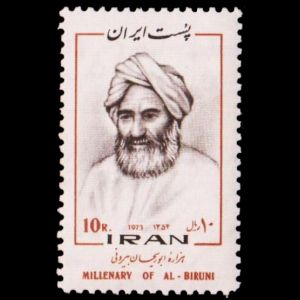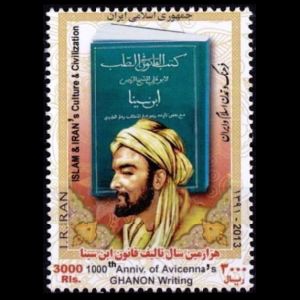the place where Paleontology and Paleoanthropology meets Philately
Iran
Neanderthals fossils and cave painting on stamps of Iran
| << previous country | back to index | next country >> |
Contents:
- Country overview
- Philately of Iran
- Some official stamp of Iran to consider
- Personalized stamps of Iran related to Paleoanthropology
- Some postmarks of Iran to consider
- References
- Acknowledgements
Iran, officially the Islamic Republic of Iran. Known as Persia until 1935, Iran became an Islamic republic in 1979 after the ruling monarchy was overthrown and Shah Mohammad Reza PAHLAVI was forced into exile.
Conservative clerical forces led by Ayatollah Ruhollah KHOMEINI established a theocratic system of government with ultimate political authority vested in a learned religious scholar referred to commonly as the Supreme Leader who, according to the constitution, is accountable only to the Assembly of Experts. The country with more than 83 million inhabitants located in Western Asia and bordered by Armenia, Azerbaijan, Turkmenistan, Afghanistan, Pakistan, Persian Gulf and the Gulf of Oman, Turkey and Iraq.
Tehran is the capital and largest city, as well as the leading economic and cultural hub.
Iran is home to one of the world's oldest civilizations, beginning with the formation of the Elamite kingdoms in the fourth millennium BC.
According to some fossils found in the country, it is suggested that Neanderthals were roaming the Iranian Zagros Mountain sometimes between 40 to 70 thousand years ago. [R1]
The first stamps of Iran issued in 1868 - set of four imperforated stamps with Steamship images.
To date (2020) there are no official stamps of Iran that relate to paleontological and paleoanthropological sciences.
Some personalized stamps with fossils and cave painting of Neanderthals were issued by the National Museum of Teheran in 2019 - the only stamps of the country to consider. [R2]
Some stamps of Iran to consider: pre-modern Natural Historians
| 21.04.1954 "Restoration of the tomb for the philosopher Avicenna/ Ibn Sina" [O2] | 16.09.1973 "1000th anniversary of Al-Biruni" [O1] | 22.08.2004 "World Congress on Avicenna / Ibn Sina, Hamadan" [O2] |
 |
 |
 |
| 05.03.2013 "1000th anniversary of Avicenna / Ibn Sina" [O2] | ||
 |
|
|
Notes:
[O1] Abu Rayhan Muhammad ibn Ahmad al-Biruni (973-1048) commonly known as al-Biruni, was a scholar and polymath during the Islamic Golden Age.
al-Biruni was born in the outer district (Bīrūn) of Kath, the capital of the Afrighid dynasty of Khwarezm (Chorasmia) in Central Asia - now part of the autonomous republic of Karakalpakstan in the northwest of Uzbekistan.
He has been called variously the "Founder of Indology", "Father of Comparative Religion", "Father of Modern Geodesy". Al-Biruni is considered by some to be the first anthropologist as he studied the customs and religions of India.
He expressed an opinion about the possibility of the Earth moving around the Sun and determined the circumference of the Earth.
He may have been the first person to suggest a standard ordering of geologic time with different eras that followed one another. In this way, he identified the concept of stratigraphy.
In his work about India, he suggested, based on fossil evidence, that the region had been under sea. It was quite innovative thinking.
In Europe, scholars and later scientists believed in an unchanging Earth and recognized fossils as a "game of nature", rather than remains of prehistoric animals until the 19th century. [R4]
[O2] Ibn Sina, known in the West as Avicenna (980-1037), was a Persian polymath who is regarded as one of the most significant physicians, astronomers, thinkers and writers of the Islamic Golden Age and the father of early modern medicine.
Ibn Sina was born in present-day Uzbekistan, which at that time was ruled over by a Persian dynasty (the Samanids).
In 1027 Ibn Sina stated in his "Book of Healing", that fossils are formed when remains of dead animals and plants are turned to stone by a petrifying virtue which seeps from the earth, perhaps during earthquakes or other slower upheavals.
“If what is said concerning the petrifaction of animals and plants is true, the cause of this (phenomenon)
is a powerful mineralizing and petrifying virtue which arises in certain stony spots, or emanates suddenly
from the earth during earthquakes and subsidences, and petrifies whatever comes into contact with it.
As a matter of fact, the petrifaction of the bodies of plants and animals is not more extraordinary than
the transformation of waters.”
Personalized stamps of Iran related to Paleoanthropology: Neanderthals fossils and cave painting.
| 15.11.2019 "Neanderthal Tooth from Zagros Mountain" [P1] | ||

|
|
|
[P1] The National Museum of Teheran issued a set with a number of personalized stamps showing artefacts of their huge collection in 2019. Three stamps are related to the stone age. The stamps themselves are ornamental tablets, with big personalized tabs attached to it. The tabs are:

 Neanderthal tooth found at Wezmeh cave by a team led by Fereidoun Biglari in 1999.
Neanderthal tooth found at Wezmeh cave by a team led by Fereidoun Biglari in 1999. Fereidoun Biglari is the co-founder and head of the Paleolithic Department in the National Museum of Iran which was established in 2001. The tooth is pictured on one of the stamps in the set and until recently was thought to be from a modern human. A collaboration between scientists from the Iran National Museum, the University of Poiters, and the University of Bordeaux confirmed that the tooth was actually from a neanderthal child.
This is the first direct evidence of the Neanderthal presence in the Iranian Zagros.
Jebrael Nokandeh, director of the Iran National Museum said the results of this new study that was published in the international "Journal of Human Evolution" definitely prove that Neanderthals lived in the Zagros region.
The Wezmeh Cave is an archaeological site near Islamabad Gharb, western Iran, around 470 km southwest of the capital Tehran. Since its discovery in 1999 several excavations were done at this site.
The only Natural History Museum in Iran is Zagros Paleolithic Museum Kermanshah, established by Fereidoun Biglari and A. Moradi Bisetouni in 2008. The museum contains a large collection of stone tools and animal fossil bones from various Paleolithic sites in Iran.
Zagros Paleolithic Museum occupies four rooms which include objects from various Paleolithic and Neolithic sites in Iran, dating from ca. 1,000,000 years to some 8,000 years ago. [R3]
Some postmarks of Iran to consider: pre-modern Natural Historians
| 22.08.2004 "Word Congress on Avicenna / Ibn Sina, Hamadan" [PMO1] | ||

|
|
|
[PMO1] The Mausoleum of Avicenna shon on several stamps of Iran: the blue stamp from the set "Restoration of the tomb for the philosopher Avicenna/ Ibn Sina" from 1954 and one of the stamps from strip "Word Congress on Avicenna / Ibn Sina, Hamadan" from 2004, as well as on the cachet of its FDC and the postmark.
The Mausoleum of Avicenna is a monumental complex located at Avicenna Square, Hamadan, Iran. Dedicated to the Persian polymathAvicenna, the complex includes a library, a small museum, and a spindle-shaped tower inspired by the Ziyarid-era Kavus Tower.
The Mausoleum was built in 1952, replacing an older building dedicated to Avicenna which was destroyed in 1950.
References:
- [R1] Iran : Wikipedia, FlagCounter.
- [R2] Postal History and Philately of Iran : Wikipedia,
-
[R3] Neanderthal Tooth from Zagros Mountain:
- The National Museum of Teheran: Wikipedia
- Fereidoun Biglari: Wikipedia, Twitter (on English),
-
Zagros Paleolithic Museum on Wikipedia
- [R4] Abu Rayhan Muhammad ibn Ahmad al-Biruni:
"Paleontology: An illustarted History", by David Bainbridge. Published in 2022,
Wikipedia, fossilbiasblog.com, islam.fandom.com. - [R5] Ibn Sina, also known as Avicenna:
"Paleontology: An illustarted History", by David Bainbridge. Published in 2022,
Wikipedia, Encyclopedia Britannica, Strange Science, Fossil Bias Blog, Muslim Heritage.- The Mausoleum of Avicenna: Wikipedia,
Acknowledgement:
Many thanks to
- Dr. Peter Voice from Department of Geological and Environmental Sciences, Western Michigan University, for the draft page review and his valuable comments.
- Mr. Alexander Pedchenko from Russia, for his help in finding some missing philatelic stuff of Iran.
| << previous country | back to index | next country >> |